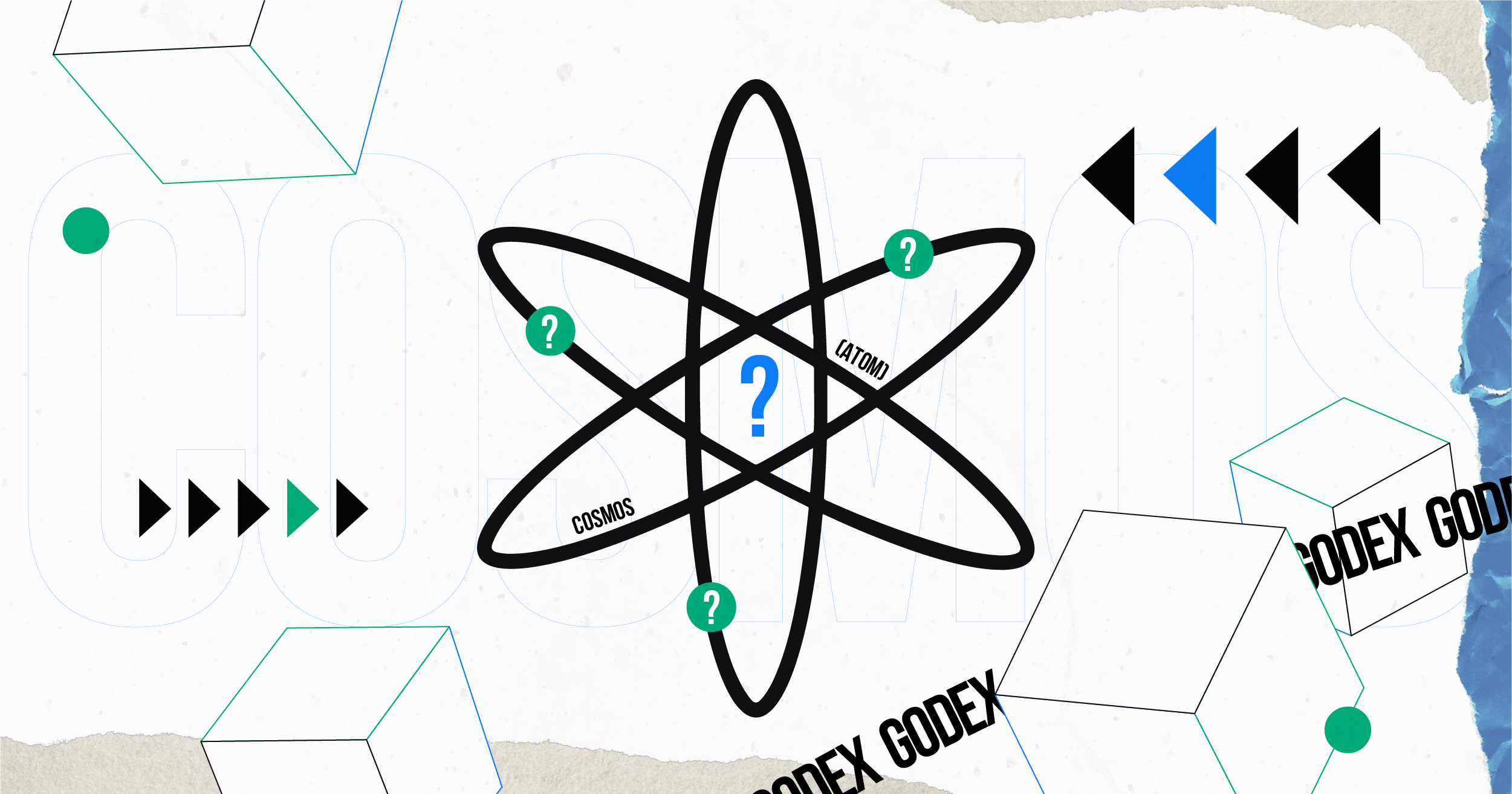Table of Contents
How can we understand that the startup, application, or project belongs to the crypto world? Recently the only feature that united miscellaneous objects and projects into the crypto world was blockchain technologies. This blockchain universe was almost closed from the other world, but it suffered from internal controversies, like the attitude to official regulations and environmental costs.
Cosmos’ founding team wants to shift the crypto world to the next level and connect various blockchains in one network, the so-called “Internet of blockchain.” Cosmos provides its software development kit (SDK) that allows creating the blockchain applications from scratch. Each new Cosmos-based application can connect to Cosmos Hub and become a part of the Cosmos network. Cosmos network uses Proof-of-Stake protocol by Tendermint and runs its Cosmos crypto named ATOM cryptocurrency.
It seems a bit complex at first glance. Let us discuss all these names and technologies to understand the idea of the Internet of blockchain.
How does Cosmos work?
So, the owners of Cosmos declare its end goal as an Internet of blockchains — many blockchain networks and applications united into a single environment. In this environment, blockchains can interact and communicate with each other, exchange data, build chains, etc. Each blockchain in this network is called a zone.
Zone
On the Internet of blockchain, a zone is an independent blockchain network. Each zone lives independently on the Cosmos ecosystem; in particular, it can issue and distribute its own tokens with no effect from Cosmos coins.
Cosmos Hub
Cosmos Hub is a point where all zones meet. Each zone can interoperate with any other zone connected directly to this hub. The hub uses Inter-blockchain Communication protocol to guarantee all information circulates freely and securely between the zones. Cosmos Hub serves as an intermediary, but it can operate separately without affecting the blockchains in the network.
Cosmos SDK
The software development kit by Cosmos allows blockchain developers to construct new zones from different blocks. Let us compare it with the site constructor: the architect can create a blockchain network in days instead of months using various plug-ins and modules.
In the plans of the authors, Cosmos should be the great ecosystem, the fruitful soil for the many blockchain initiatives. However, it would be impossible without Tendermint and its Proof-of-Stake protocol.
What is Tendermint?
We should review two sides of Tendermint: blockchain consensus protocol Proof-of-Stake and a powerful engine for blockchain application development.
Initially, the blockchain networks used the Proof-of-Work verification protocol. To verify the transaction in the decentralized network, it is necessary to approve it with three independent nodes. If you transferred Bitcoin from one wallet to another, you had to wait for all three approvals. The miners also use this protocol to add new Bitcoin blocks to the network.
The PoW protocol is a suitable compromise for blockchain systems, but it has some opposing sides. First, PoW is responsible for the enormous amount of power needed for Bitcoin mining and verification. More problems are coming. As you know, the number of nodes in the Bitcoin network is limited. Each new node requires higher energy consumption to be mined. The number of miners decreases all the time because of the growing mining costs. At some point, the network can become vulnerable to 51% attack — verification with fraudulent accounts. So the blockchain community considers alternative options.
Tendermint offers another protocol — Proof-of-Stake, which connects the transaction validation with the number of coins owned by the individual. Of course, this protocol is not perfect as well. The primary concern is that the major stakers become more influential that contradicts the democratic spirit of the decentralized networks. However, it opens some new perspectives for the blockchain community.
In particular, Tendermint BFT engine allows the creation of the blockchain application without development it from scratch. This engine opens the opportunity for numerous startups. They use PoS protocol and Cosmos software as a base. Proof-of-Stake requires less energy, it does not depend on the mining and allows the users in the network to get some additional income for the transaction verification.
Who Invented Cosmos?
As we mentioned above, Tendermint team owners invented Cosmos. The key names are Zarko Milosevic, Jae Kwon, and Ethan Buchman. Kwon introduced Tendermint in 2014, then invited Milosevic and Buchman, and they co-founded Cosmos in 2017. Their co-founder is ICF, a Swiss non-profit that supports open-source blockchain projects.
In 2017 they also introduced Cosmos on the ICO and launched ATOM as a native coin for Cosmos. The platform raised 17 million during ICO.
What are ATOMs?
So, ATOM is a native coin issued by the Cosmos platform. We can call it Cosmos cryptocurrency. It functions with no effect for the blockchain zones in the Cosmos ecosystem. ATOMs can be exchanged for crypto and fiat currencies, and they can also be a source of passive income for a holder. In the Proof-of-Stake protocol by Tendermint top 100 ATOM stakers can approve the transactions in the system and get a reward. In this way, Cosmos motivates its users to own more ATOMs and removes the nefarious nodes from the verification process.
How to buy ATOM
ATOMs (Cosmos crypto) can be purchased on the many cryptocurrency exchanges, usually for Bitcoin, Ethereum, Tether, or fiat currencies. Choose the exchange service that works in your regions: Binance is probably the best in the world, but it is unavailable for USA users. If you are in the USA, try Kraken or another service. For European residents, we recommend BitPanda.
The highest registered price, for now, is $8.36 per ATOM. ATOMs cannot be mined.
Currently, 204,603,576 ATOMs are in circulation; most of them came from the initial Cosmos launch. They are distributed between the platform owners, initial investors, and leading platform developers.
What can you do with ATOMs?
You can buy ATOMs for short-time storage or long-term investments. Use the electronic wallet if you want to keep your ATOM coins and then exchange them for another crypto or fiat currency. Many services offer free crypto wallets: choose one of these and make sure it offers two-step verification. Keep your password separately from the wallet, and your coins will stay safe.
If you plan to buy some ATOMs for long-term investment, you’d better use the hardware store. Purchase a special device — it looks like a flash memory chip — save your assets here, then unplug it from your computer. Offline storage will keep your coins safe from online threats.
The Future of Cosmos Crypto
Nobody can guarantee Cosmos crypto will develop quickly and flawlessly. For now, several visible challenges can speed down Cosmos growth. Let us discuss the most obvious problems.
The first challenge is Cosmos Hub scalability. The number of available direct connections cannot be limitless for one Cosmos hub. Thus, the Internet of blockchain should represent the group of hubs where each hub interoperates with the group of blockchain zones. However, in this scheme, the mechanism of connection between two blockchains from different hubs looks too complicated. Probably, the zones can form the chains directly.
Another challenge is no-Tendermint chains. Some crypto players believe in PoS but do not want to deal with Tendermint. For example, popular cryptocurrency Cardano develops its network with PoS protocol, and Ethereum prepares to launch a new PoS-based system, the so-called Ethereum 2.0. The question is how these new no-Tendermint systems will interact with each other and with their Tendermint counterparts.
Conclusion
Integration and unification — here are two fundamental principles in the software industry nowadays. No unique service or app can survive if it cannot integrate effectively with its counterparts. Correspondingly, the successful integration requires some unification in data formats, protocols, and security standards.
The crypto world suffers from a lack of unification. In particular, all discussions about the regulations for the crypto market stop at the point of the industry standards.
So, the blockchain world needs solutions like Cosmos. If cryptocurrencies want to get legal status in the leading countries, they should follow some regulations. Otherwise, their status will fluctuate from the reserve asset to a payment method for criminals and grey businesses. The regulation is impossible without unification and standardization, and Cosmos is an appropriate solution. Thus, Cosmos will flourish until some changes in this market.
Start a Cryptocurrency exchange
Try our crypto exchange platform
Disclaimer: Please keep in mind that the content of this article is not financial or investing advice. The information provided is the author’s opinion only and should not be considered as direct recommendations for trading or investment. Any article reader or website visitor should consider multiple viewpoints and become familiar with all local regulations before cryptocurrency investment. We do not make any warranties about reliability and accuracy of this information.
 Alex Tamm
Alex Tamm 
Read more
Ripple (XRP) price has been widely discussed by the cryptocurrency community since it has gained public interest in 2017, even though it was founded by Chris Larsen and Jed McCaleb years before. The platform offers innovative blockchain solutions for the banking sector and has the potential to disrupt the whole finance industry. In recent years, […]
In this article we will talk about Ripple (XRP) and its price prediction. What is Ripple (XRP) Ripple is a San Francisco-based startup that was launched in 2012 by Ripple Labs as a global network both for cross-currency and gross payments. Ripple history began in 2004 with the discussions around the digital coin in the […]
You may well think that an article dedicated to a Tether price prediction or the Tether price in general is a little bit strange — it is a stablecoin after all. However, the price of Tether does fluctuate significantly, although it is nowhere near as volatile as non-stablecoin cryptos. This means that staying up to […]
In the article we share our vision at Zcash cryptocurrency main features and add several price predictions. As cryptocurrencies gain global acceptance and decentralisation slowly enters our lives, privacy becomes the main concern when talking about blockchain adoption. It is no secret that distributed ledger is by far the most secure and transparent technology ever […]
Chiliz coin (CHZ) offers a compelling opportunity for traders interested in the intersection of blockchain technology and sports. By enabling fans to influence team decisions through the Socios app, Chiliz directly monetizes fan engagement and connects with major sports teams like Juventus and Paris Saint-Germain. These partnerships not only enhance the platform’s visibility but also […]
The exponential growth of Bitcoin Satoshi Vision (BSV) against the general bear trend on the cryptocurrency market in autumn 2019 has impressed the community. Due to the increasing market capitalization, the newly emerged altcoin was ranked 5th on CoinMarketCap and managed to maintain its high position at the beginning of 2020. In the article we […]